Agricultural Sciences Questions - Grade 12 June 2021 Exemplars
Share via Whatsapp Join our WhatsApp Group Join our Telegram GroupINSTRUCTIONS AND INFORMATION
- This question paper consists of TWO sections, namely SECTION A and SECTION B.
- Answer ALL the questions in the ANSWER BOOK.
- Start EACH question on a NEW page.
- Number the answers correctly according to the numbering system used in this question paper.
- You may use a non-programmable calculator.
- Show ALL your calculations, including units and formulae, where applicable.
- Write neatly and legibly.
QUESTIONS
SECTION A
QUESTION 1
1.1 Various options are provided as possible answers to the following questions. Choose the answer and write only the letter (A–D) next to the question numbers (1.1.1–1.1.10) in the ANSWER BOOK, for example 1.1.11 A.
1.1.1 An animal deficient in cobalt will show symptoms of … disease.
- osteomalacia
- parakeratosis
- swayback
- wasting
1.1.2 During … nutrient molecules move against the concentration gradient.
- active transport
- osmosis
- passive transport
- diffusion
1.1.3 The following volatile fatty acids are the end product of fermentation that is absorbed in the wall of the rumen:
- Carbonic acid, butyric acid and propionic acid
- Butyric acid, acetic acid and propionic acid
- Propionic acid, hydrochloric acid and acetic acid
- Ammonia, acetic acid and propionic acid
1.1.4 The following occurs in the abomasum:
- Secretion of gastric juices, hydrochloric acid and digestive enzymes
- Churning of food by muscular walls into chyme
- Microbial hay fermentation results in the production of volatile fatty acids
- Pepsin and rennin are secreted in the abomasum to digest proteins and curdle milk respectively
Choose the correct combination below:
- (i), (ii) and (iv)
- (ii), (iii) and (iv)
- (i), (ii) and (iii)
- (i), (iii) and (iv)
1.1.5 The instrument or equipment shown in the picture below is used by farmers to manage animal diseases and is known as a(n) …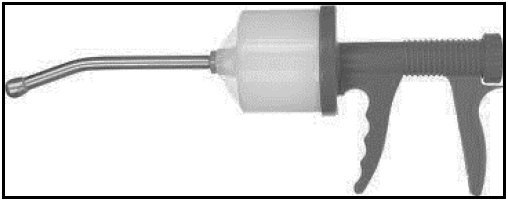
- injection gun.
- spraying gun.
- drenching gun.
- balling gun.
1.1.6 The possible advantages of a feedlot in animal production are listed below:
- Stocking density is increased
- Weaning stress on female animals is increased
- Zero grazing is applied
- The production output is increased
Choose the correct combination below:
- (i), (ii) and (iv)
- (i), (ii) and (iii)
- (ii), (iii) and (iv)
- (i), (iii) and (iv)
1.1.7 The most effective way to prevent viral diseases in farm animals is to use ...
- dosing.
- vaccination.
- dipping.
- antibiotics.
1.1.8 A process where superior cows are treated with hormones to allow production of more mature ova during a single oestrus cycle:
- Synchronisation of oestrus
- Nuclear transfer
- Embryo flushing
- Superovulation
1.1.9 The main reason for drying off a high-producing dairy cow before she starts her next lactation period is to ...
- ensure that the cow becomes pregnant early.
- shorten the gestation period.
- allow recovery of tissue and glandular material.
- reduce problems during parturition.
1.1.10 ONE of the factors listed below can cause sterility in bulls:
- Cryptorchidism
- Freemartinism
- Retained placenta
- Metritis (10 x 2) (20)
1.2 Indicate whether each of the following descriptions in COLUMN B applies to A ONLY, B ONLY, BOTH A AND B or NONE of the items in COLUMN A. Write A only, B only, both A and B or None next to the question number (1.2.1–1.2.5) in the ANSWER BOOK, for example 1.2.6 B only.
COLUMN A | COLUMN B | ||
1.2.1 | A: | Urea | Recommended as a supplement for protein in the ration of ruminant animals |
B: | Biuret | ||
1.2.2 | A: | Pancreatic juice | The juice in the digestive system that neutralises acidic condition |
B: | Bile juice | ||
1.2.3 | A: | Protozoan | An example is heartwater disease |
B: | Fungal | ||
1.2.4 | A: | Farrowing pen | Narrow stalls used in intensive farming to keep pregnant sows throughout the 16 weeks period |
B: | Gestation crates | ||
1.2.5 | A: | Maceration | Sign of parturition in cows and heifers |
B: | Mummification | ||
(5 x 2) (10)
1.3 Give ONE term/phrase for each of the following descriptions. Write only the term/phrase next to the question number (1.3.1–1.3.5) in the ANSWER BOOK.
1.3.1 The deficiency symptom in farm animals caused by a shortage of iron leading to paleness
1.3.2 Protein substances produced by white blood cells in response to specific foreign antigens
1.3.3 A collective name for classifying mites, nasal worms and lice
1.3.4 The condition where the bull is interested in a cow, but lacks the ability to service it
1.3.5 The type of nuclear transfer where embryonic stem cells are produced for medical reasons (5 x 2) (10)
1.4 Change the UNDERLINED WORD(S) in EACH of the following statements to make them TRUE. Write only the answer next to the question numbers (1.4.1–1.4.5) in the ANSWER BOOK.
1.4.1 The Punnett square is a method used to determine the ratio of two feeds to get a required nutrient value.
1.4.2 Maintenance feeding is a protein enriched feed given to piglets to attain a higher weaning weight.
1.4.3 Infertility is the total loss of fertility which cannot be corrected if diagnosed.
1.4.4 Gestation describes abnormal conditions that interfere with normal parturition.
1.4.5 An instrument used for the recovery of fertilised eggs during embryo transfer is known as pistollete.
(5 x 1) (5)
TOTAL SECTION A: 45
SECTION B
QUESTION 2: ANIMAL NUTRITION
Start this question on a NEW page.
2.1 The diagrams below represent the alimentary canals of farm animals.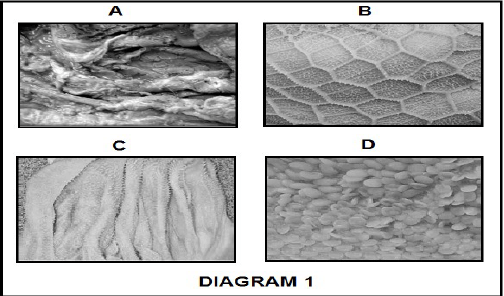

2.1.1 Identify parts represented by letters B, C and G from DIAGRAM 1 and DIAGRAM 2 above. (3)
2.1.2 Classify the animal with an alimentary canal such as the one in DIAGRAM 2. (1)
2.1.3 Justify with a visible reason the answer in QUESTION 2.1.2. (1)
2.1.4 Identify the letter of the part in DIAGRAM 2 that performs the same function as part A in DIAGRAM 1. (1)
2.1.5 Identify the letter (A–H) that represents the part where each of the following occurs:
- Maximum absorption of digested nutrients (1)
- Main site for the absorption of volatile fatty acids (1)
2.2 Suggest the name of the vitamin that causes the following deficiency symptoms:
2.2.1 Rickets which causes porous bones in young animals (1)
2.2.2 Curled toe paralysis in chickens (1)
2.3 The pictures below show different animal feeds.
Identify the feed from the pictures above that can be associated with each of the following purposes:
2.3.1 Improve fertility in rams (1)
2.3.2 Correct mineral deficiencies (1)
2.3.3 To finish off beef animals for the abattoir (1)
2.3.4 Supply bulkiness in rations for ruminants (1)
2.4 The feeds below are available to compile a ration for farm animals.
FEEDS | COMPOSITION INDICATORS | NUTRITIVE RATIO (NR) | |||
Dry matter (%) | Moisture (%) | TDN (%) | DP (%) | ||
Maize meal | 85 | 15 | 75 | 10 | 1 : 7 |
Sunflower oil-cake meal | 89 | 11 | 85 | 17 | |
Silage | 80 | 20 | 65 | 7 | 1 : 8 |
2.4.1 Identify from the above table an example for each of the following:
- Concentrate (1)
- Roughage (1)
2.4.2 A heifer was fed 25 kg of silage from the above table and it excreted 8 kg of dry manure. Calculate the digestibility co-efficient of silage. Show ALL calculations. (5)
2.4.3 Calculate the nutritive ratio (NR) of sunflower oil-cake meal. Show ALL calculations. (3)
2.4.4 Categorise the NR value of sunflower oilcake meal and maize meal. (2)
2.4.5 Justify, with a reason, the suitability of sunflower oil-cake meal for the fattening of matured animals. (2)
2.5 The pie chart below illustrates a fodder-flow programme for a farm in South Africa.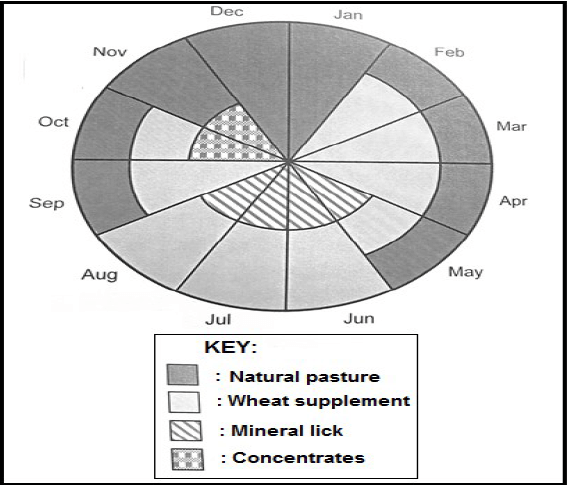
2.5.1 Identify the month during which the farmer only used natural pasture to feed farm animals. (1)
2.5.2 Justify the answer in QUESTION 2.5.1 by referring to the above pie chart. (1)
2.5.3 The farmer revealed that the farm supplied 4,3 tons of natural pasture in December.
- Determine the amount of natural pasture, in kilograms, that will be needed in December to feed 45 sheep if each sheep consumes 2,5 kg natural pasture per day. (2)
- The sheep farmer experienced a surplus. Justify this statement by calculating the surplus amount. Show ALL calculations.(3)
[35]
QUESTION 3: ANIMAL PRODUCTION, PROTECTION AND CONTROL
Start this question on a NEW page.
3.1 The pictures below represent two animal production systems.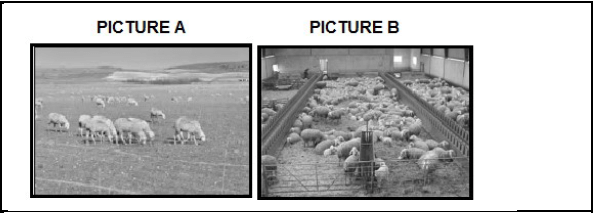
3.1.1 Identify the animal production systems represented in PICTURE A and PICTURE B above. (2)
3.1.2 Justify the answer in QUESTION 3.1.1 based on the following:
- Sustainable use of natural resources (2)
- Capital investment (2)
3.1.3 Indicate the farming system associated with each of the animal production systems identified in QUESTION 3.1.1. (2)
3.2 The pictures below shows housing facilities for farm animals.
3.2.1 Identify FACILITY 1 and FACILITY 2 in the picture above. (2)
3.2.2 Indicate the main purpose of part A in FACILITY 1 and part B in FACILITY 2 (2)
3.2.3 Name ONE equipment that can be found in FACILITY 1. (1)
3.2.4 Indicate TWO ways in which farm animals can lose body heat if FACILITY 1 is not provided. (2)
3.3 The table below represents different animal diseases commonly found in South Africa.
DISEASES | TYPE OF ANIMAL | PATHOGEN | MAIN SYMPTOMS | PREVENTAT IVE MEASURE |
A | Pigs | Virus | Vomiting and bleeding from the nose and rectum | Slaughter and disposal of infected animals and their products |
Anthrax | Cattle, sheep goats, horses and pigs | B | Swelling of neck and throat resulting in respiratory distress, muscle tremors with staggers and convulsions | C |
Heartwater | Cattle, sheep and goats | D | Thin diarrhoea with intestinal mucosa and blood | Good sanitation. Prevention of overcrowding |
E | Cattle, sheep, goats and pigs | F |
| Isolation of infected animals |
3.3.1 Complete the table by providing labels for letters A–F. (6)
3.4 The following table indicates the number of reported rabies outbreak cases per province in South Africa.
Province | Number of reported cases of rabies in 2017 | Reported cases of rabies as a percentage (%) in 2017 | Number of reported cases of rabies in 2018 |
Eastern Cape | 12 | 14 | 6 |
Free State | 9 | 10 | 3 |
Gauteng | 5 | 6 | 2 |
KwaZulu-Natal | 20 | 23 | 10 |
Western Cape | 3 | 3 | 2 |
Northern Cape | 6 | 7 | 3 |
Limpopo | 17 | 20 | 8 |
Mpumalanga | 10 | 12 | 5 |
North West | 4 | 5 | 2 |
3.4.1 Draw a bar graph representing the percentages of reported rabies cases per province in South Africa. (5)
3.4.2 Explain the trend of reported rabies cases from the table. (2)
3.4.3 Indicate the possible reason for the trend observed in QUESTION 3.4.2. (1)
3.5 Parasites live on the animal as a host and may cause harm that reduces production.
3.5.1 Provide an example for each of the following categories of ticks:
- Single-host ticks
- Three-host ticks (2)
3.5.2 Indicate TWO application methods used to control ectoparasites chemically. (2)
3.6 Name TWO services rendered by the state to protect animals from infection by diseases. (2)
[35]
QUESTION 4: ANIMAL REPRODUCTION
Start this question on a NEW page.
4.1 The diagram below illustrates the reproductive system of a bull.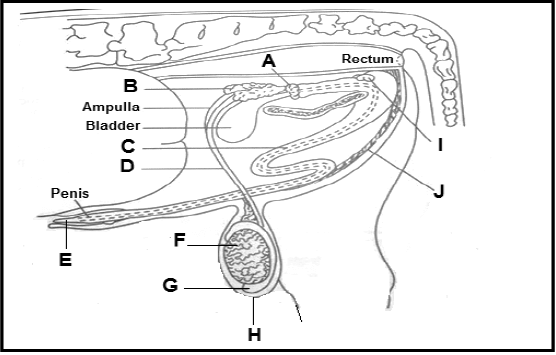
4.1.1 Identify the parts labelled B, C and E from the above DIAGRAM. (3)
4.1.2 Indicate the process taking place in part F. (1)
4.1.3 Give TWO functions of the hormone secreted in part F. (2)
4.1.4 Match the functions listed below with a letter (A–H) from the diagram above:
- Stores and allows the spermatozoa to mature (1)
- Secretes a substance that lubricates and cleans the urethra for ejaculation (1)
- Provide nutrients for the sperm cells (1)
4.1.5 Explain the importance of part H in the control of temperature for effective functioning of parts F and G. (2)
4.2 The diagram below illustrates a reproductive process occurring in farm animals.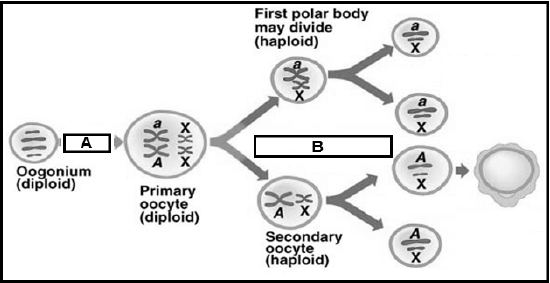
4.2.1 Identify the reproductive process illustrated in the diagram above. (1)
4.2.2 Indicate the name of an organ where the reproductive process identified in QUESTION 4.2.1 occurs. (1)
4.2.3 Name the division process taking place at A and B in the above diagram. (2)
4.3 The oestrogen hormone assists the cow with the initiation of oestrus signs.
4.3.1 Define the term oestrus. (2)
4.3.2 State TWO visible signs of oestrus in cows. (2)
4.3.3 Indicate TWO practical methods a farmer can use in identifying cows on heat. (2)
4.4 The list below represents stages during nuclear transfer process:
- Transferred into the uterus of recipient cows to grow until adulthood
- Enucleation of an unfertilised egg
- Manipulated cell is artificially activated to start dividing until it is a blastocyst
- Egg is treated and cultured in the laboratory for fusion to take place
- Nucleus containing DNA from donor is transferred into cytoplasm of the enucleated egg
Re-arrange the stages of nuclear transfer process presented in the list above into its chronological order. (5)
4.5 Give the name of a(n) organ/structure where each of the following female hormones are produced:
4.5.1 Oestrogen (1)
4.5.2 Gonadotrophic releasing hormone (GnRH) (1)
4.5.3 Progesterone (1)
4.5.4 Follicle-stimulating hormone (FSH) (1)
4.5.5 Oxytocin (1)
4.6 Multiple births is the phenomenon occurring in farm animals.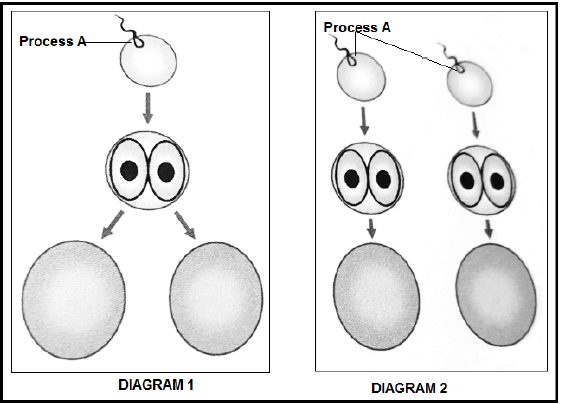
4.6.1 Identify the type of multiple births represented by DIAGRAM 1 and DIAGRAM 2. (2)
4.6.2 Justify the answer in QUESTION 4.6.1. (2) [35]
TOTAL SECTION B: 105
GRAND TOTAL: 150